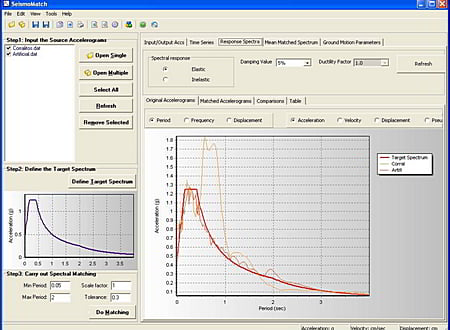SeismoMatch is an application capable of adjusting earthquake accelerograms to match a specific target response spectrum, using the wavelets algorithm proposed by Abrahamson [1992] and Hancock et al. [2006] or the algorithm proposed by Al Atik and Abrahamson [2010]. Some of its features are:
- Simultaneous matching of a number of accelerograms, and then creation of a mean matched spectrum whose maximum misfit respects a pre-defined tolerance.
- Possibility of using this software in combination with records selection tools and records appropriateness verification algorithms to define adequate suites of records for nonlinear dynamic analysis of new or existing structures.
- Capability of reading single accelerograms defined in both single- or multiple-values per line formats (the two most popular formats used by strong-motion databases) or of reading a number of accelerograms at the same time (if they are defined in the single-value per line format).
- Creation of the target spectrum by following rules from a selection of more than 25 National Building Codes including Eurocode 8 rules, ASCE 41-13 and various Regulations worldwide, by computing the spectrum of a specific accelerogram or by simply loading a user-defined spectrum.
The following strong-motion parameters are then computed for the matched accelerograms:
- Elastic response spectra and pseudo-spectra
- Overdamped and constant-ductility inelastic response spectra
- Root-mean-square (RMS) of acceleration, velocity and displacement
- Arias (Ia) and characteristic (Ic) intensities
- Cumulative absolute velocity (CAV) and specific energy density (SED)
- Acceleration (ASI) and velocity (VSI) spectrum intensity
- Housner intensity
- Sustained maximum acceleration (SMA) and velocity (SMV)
- Effective design acceleration (EDA)
- Predominant period (Tp)
- Significant duration
In addition, SeismoMatch also features a module in which a user can combine many matched accelerograms in order to obtain a combined mean spectrum that fulfils the user's requirements regarding maximum and mean misfit.
Finally, and due to its full integration with the Windows environment, SeismoMatch allows for numerical and graphical results to be copied to any Windows application (e.g. MS Excel, MS Word, etc.), noting that the plots characteristics can be fully customised from within the program itself.
* SeismoMatch download link provides trial version of the software.
Generating artificial earthquake accelerograms
SeismoArtif is an application capable of generating artificial earthquake accelerograms matched to a specific target response spectrum using different calculation methods and varied assumptions.
Analytical assessment of structures subjected to earthquake strong motion
SeismoStruct is a Finite Element package capable of predicting the large displacement behaviour of space frames under static or dynamic loading, taking into account both geometric nonlinearities and material inelasticity.
SEISAN analysis software suite is a complete set of programs and an uncomplicated database for analyzing earthquakes from analog and digital data.
Processing of strong-motion data
SeismoSignal constitutes an easy and efficient way to process strong-motion data, featuring a user-friendly visual interface and being capable of deriving a number of strong-motion parameters often required by engineer seismologists and earthquake enginee
Library of ground motion records
SeismoSpect constitutes a simple and efficient platform that allows to create a personal library of ground motion records and save them all in a single file making it easy to handle and share large numbers of records.
Submit a review about SeismoMatch software with your social media profile







No comments yet. Be the first to comment.